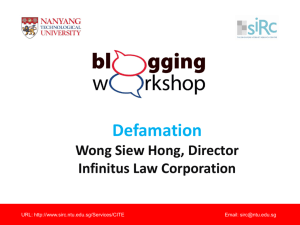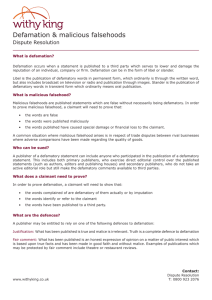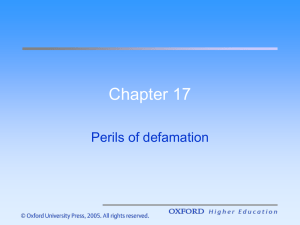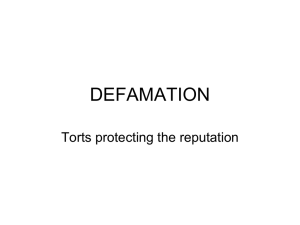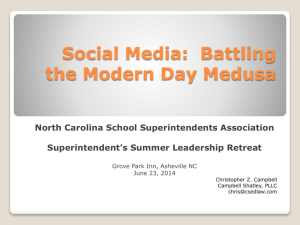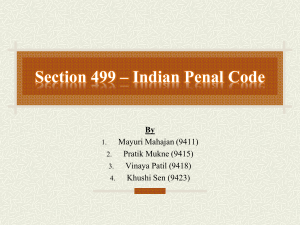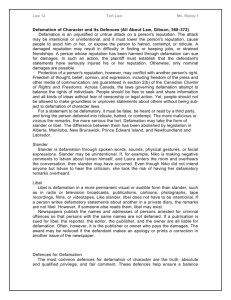Companies and Securities Law
advertisement
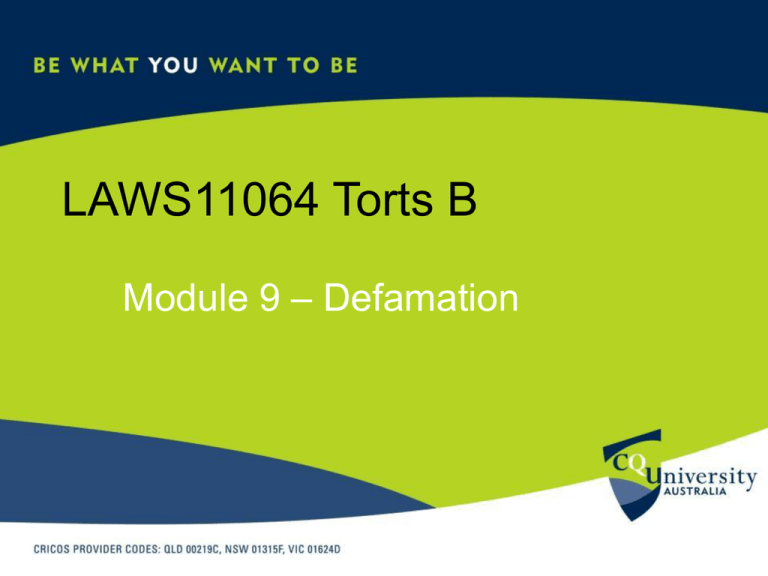
LAWS11064 Torts B Module 9 – Defamation Objectives At the end of this module you should be able to: • • • • • Understand the elements of defamation; Assess the extent to which defamation law protects privacy; Apply the elements of defamation to particular fact scenarios; Understand the defences relating to defamation; and Apply the defences to particular fact scenarios. This week: Part 1 Part 2 • Elements of Defamation • Defamatory matter • Referable to the Pl • Publication • Defences under Common Law and Statute • Remedies Defamation flowchart: Statement Offer to make amends Accepted by Pl – matter ends Offer to make amends rejected by Pl or not made by publisher No Step 1: Is the material defamatory? Pl fails Yes Step 2: Does the statement refer to or identify the Pl? No Pl fails Yes Step 3: Was the statement published? No Pl fails Yes Step 4: Does the Def have any defences? Yes Defendant wins case or damages are reduced No Pl wins. Awarded damages and/or injunction 1. Is the matter defamatory? ‘a publication, without justification or lawful excuse, exposing a person to hatred, contempt or ridicule, calculated to injure that person’s reputation’ (Random House Aus P/L v Abbott (1999) 167 ALR 224). Lowers the Pl in the estimation of others Exposes Pl to hatred, ridicule or contempt Causes Pl to be shunned or avoided Defamatory matter cont. Lowers the Pl in the estimation of others if a publication causes the reasonable person to think less of the Pl: Reader’s Digest Services v Lamb (1982) 150 CLR 500. injured feelings or pride not enough: Boyd v Mirror Newspapers Ltd [1980] 2 NSWLR 449. Must disparage (or impute blame) to Pl: eg. John Fairfax & Sons Ltd v Punch (1980) 31 ALR 624 (that political leader had lost confidence of party held to be defamatory). cf. Sungravure P/L v Middle East Airlines Airliban SAL (1975) 134 CLR 1 (no defamation to state airline was target of terrorist attacks). See Boyd (above). Defamatory matter cont. • Exposes Pl to hatred, ridicule or contempt: Ettinghausen v Australian Consolidated Press (1991) 23 NSWLR 443 Berkoff v Burchill [1996] 4 All ER 1008 (actor described as ‘hideously ugly’, held defamatory) Saying Pl is homosexual? Clearly defamatory previously, and possibly today if the Pl is in heterosexual marriage (see Cruise v Express Newspapers plc [1999] QB 931). See also, Anti-Discrimination Act 1991 (Qld) which makes it unlawful to publish matter inciting hatred, contempt or ridicule on grounds of race, sexual orientation, sexuality or transgender status. Image source: Cory Doctorow (flickr) • Causes Pl to be shunned or avoided: Youssoupoff v MetroGoldwyn-Mayer Picture Ltd (1934) 50 TLR 581 (held that is was defamatory to suggest that Pl had been raped). Monson v Tussaud’s [1894] 1 QB 671 (Def defamed Pl by including near murderer’s gallery). Hypothetical Referee “… whether the alleged libel is established depends on the hypothetical referees who are taken to have a uniform view of the meaning of the language used and upon the standards, moral or social, by which they evaluate the imputation they understand to have been made. They are taken to share a moral or social standard by which to judge the defamatory character of that imputation being a standard common to society generally” (per Brennan J Reader’s Digest Services v Lamb (1982) 150 CLR 500 at 506) Farquhar v Bottom [1980] 2 NSWLR 380: ‘the ordinary reasonable reader is a person of fair average intelligence, who is neither perverse, nor morbid or suspicious of mind, nor avid for scandal’ See criticism from Kirby J in Favell v Qld Newspapers (2005) 221 ALR 186 Pleading defamatory meaning Natural & Ordinary Meaning • may therefore include any implication or inference which a reasonable reader, guided not by any special but only by general knowledge … would draw from the words” (Jones v Skelton [1963] 3 All ER 952). • Any strained, or forced, or utterly unreasonable interpretation of words must be rejected: Jones v Skelton; Favell v Qld Newspapers (2005) 221 ALR 186. But Lord Devlin noted in Lewis v Daily Telegraph [1964] AC 234, ‘ordinary readers draw implications much more freely, especially when they are derogatory’ (at 11). Implied Meaning • False (popular) innuendo •secondary meaning that is implied by reading between the lines (eg. Fraud squad is investigating) •statement that Pl under investigation does not imply guilt: Lewis v Daily Telegraph [1964] AC 234. • True Innuendo •alleged meaning arises from the natural and ordinary meaning of the words being read in light of other facts not mentioned in the publication •Cassidy v Daily Mirror Newspapers [1929] 2 KB 321 •Special facts and knowledge must be pleaded to support a true innuendo: Youssoupoff v MGM (1934) 50 TLR 581 •Only one cause of action arises: Composite Buyers v Clarke [1988] 2 Qd R 602 2. Reference to Pl • If Pl named, there is sufficient identification • Innocently using fictitious name may be defamatory to person of same name if publication reasonably referable to them: Hulton (E) & Co v Jones [1910] AC 25. • Same if Def intends to refer to different person to Pl: Lee v Wilson (1934) 51 CLR 276; Hall v Qld Newspapers [2002] 1 Qd R 376 • Identification of Pl may also be by photograph or picture, or may refer to them by their title – eg Prime Minister. See Henry v TVW Enterprises Ltd [1990] WAR 475. 2. Reference to Pl: Defamation of Group • Not actionable by individual members unless statement is capable of referring to all individual members (Random House v Abbott & Costello (1999) 167 ALR 224 or if reasonably referable to them (Godhard v James Inglis & Co Ltd (1904) 2 CLR 78). • Generally assumed statements about sizeable groups don’t defame individual members as readers know it may not be true of everyone: Knupffer v London Express Newspaper [1944] AC 116. ‘these blokes’ and ‘ministers’ reasonably referable to particular members of cabinet. Bjelke-Peterson v Warburton & Burns [1987] 2 Qd R 465 See also, Mann v Medicine Group (1991) 105 FLR 419 (defamation of bulk-billing doctors not referable to individual members). Cf Lloyd v David Syme & Co [1986] AC 350 (article reasonably referable to captain of cricket team). See Ballina Shire Council v Ringland (1994) 33 NSWLR 680 (local council unable to rely on defamation to stop critics. Individual members may sue if identifiable damage to reputation). Disclaimers • disclaimers will be taken into account when determining whether the publication is reasonably referable to the Pl • If reasonable person would still believe the defamatory material is referring to the Pl, then the Def will be held liable – regardless of the disclaimer (see for eg. Australian Broadcasting Corporation v Hanson [1998] QCA 306 3. Publication Statement must be made to someone other than Pl: Pullman v W Hill & Co Ltd [1891] 1 QB 524. Statement to Def’s spouse is not published, but one to Pl’s spouse is: Wennhak v Morgan (1888) 20 QBD 635. Internet: material on web, emails, bulletin boards/forums included. Dow Jones & Co v Gutnick (2002) 210 CLR 575 (publication when downloaded material becomes comprehensible). Each time statement repeated (including by other persons) = new publication. Original Def liable if foreseeable. Repeater may also be liable. If letter to Pl opened by someone else, published if reasonably foreseeable that someone else would read. Huth v Huth [1915] 3 KB 32 (not foreseeable that butler would open letter); contrast Theaker v Richardson [1962] 1 WLR 151 (RF that Pl’s husband would read letter). No publication if Pl is company and third party is employee in course of ordinary business: State Bank of NSW v Currabubula Holdings (2001) 51 NSWLR 399. Image source: nicubunu (openclipart) Dead Pl’s and Limitation Periods Can a dead person be defamed? Generally, no. Section 10 of the Act provides: A person (including a personal representative of a deceased person) can’t assert, continue or enforce a cause of action for defamation in relation to – (a) the publication of defamatory matter about a deceased person (whether published before or after his or her death); or (b) the publication of defamatory matter by a person who has died since publishing the matter. Limitation period: if published after Jan 2006, 1yr period from date of publication applies (section 10AA Limitation of Actions Act 1974). May be extended to 3 yrs if court satisfied that action could not reasonably be commenced within 1yr. Part 2: Defences to Defamation • • • • • • • • • • Justification – s 25 Defamation Act Contextual Truth – s 26 Absolute Privilege – s 27 Publication of Public Documents – s 28 Fair reports of proceedings of public concern – s 29 Qualified privilege – s 30 Honest opinion – s 31 Innocent dissemination – s 32 Triviality – s 33 Offer to make amends – Pt 3, Div 1 Defences: Justification s. 25: ‘It is a defence to the publication of defamatory matter if the Def proves that the defamatory imputations carried by the matter of which the Pl complains are substantially true’. Justification A complete defence at common law: Crowley v Glissan (No 2) (1905) 2 CLR 744. “True in substance” (each and every statement of fact must be accurate); “true in effect” (reasonable person should not be able to draw any inference from the matter that is not true). Defences: Contextual Truth s. 26 Defamation Act; common law. Applies if: in addition to the defamatory imputations, the matter contained one or more other imputations that are substantially true (the contextual imputations); and because of the substantial truth of the contextual imputations, the plaintiff’s reputation was not further harmed by the defamatory imputations. Eg of defence found in: John Fairfax Publications v Zunter [2006] NSWCA 227. Defences: Absolute Privilege s. 27 Defamation Act and common Judicial proceedings and law. Applies: their reports. Required for administration of justice (Cabassi v Vila (1940)) Statements made during sittings in Parliament, in parliamentary papers, and in government or statutory inquiries Communications between officers of state in course of official duties privileged at common law: Chatterton v Secretary of State for India [1895] 2 QB 189. Allows people to say exactly what they like without fear of legal proceedings Applies to judges, parties to the action, witnesses, legal practitioners and jurors. At common law, also applies to proceedings of quasi-judicial bodies. Communications between spouses protected at common law (Wennhak v Morgan (1888) 20 QBD 635) Defences: Public Documents and Public Proceedings Public documents – s. 28 Defamation Act • material in dispute was contained in a public document, or a fair copy, summary or extract from a public document • includes, but is not limited to, reports by a parliamentary body, a judgment by a court, government documents and records open to the public Fair report of proceedings of public concern – s 29 • If the matter was, or was contained in, a fair report of any proceedings of public concern. • ‘proceedings of public concern’ defined in s. 29 • Defence lost if Pl proves it was not published honestly and for the information of the public or advancement of education (s. 29(3)). Defences: Qualified Privilege s. 30: - if recipient has interest or apparent interest in having info on some subject, and -is published in the course of giving that information, and - the Def’s conduct was reasonable. Categories of qualified privilege are not closed: Herald & Weekly Times Ltd v Popovic [2003] VSCA 161 at [69]. At common law, common theme is interest or duty to publish the defamatory material. Defence lost if actuated by ill will or improper motive. a complete defence Chetwynd v Armidale Dumaresq Council [2010] NSWSC 690: ‘statutory qualified privilege is not subject to the requirement of reciprocity which applies to common law qualified privilege. The statutory defence is subject to the requirement that the recipient of the publication have an interest or apparent interest in having information on the subject’. Defences: Honest opinion s. 31 and at common law aka “fair comment” Comment not ‘honest’ if Def motivated by malice (Comalco Ltd v ABC (1985)) Requires: • Expression of opinion of Def • Not a statement of fact • Related to matter of public interest and • Based on proper material Opinion must be ‘fair’ (O’Shaughnessy v Mirror Newspapers (1970) If opinion also contains statements of fact, facts as expressed must be true and correct: ABC v Comalco Ltd (1986) 68 ALR 259 Defences: Innocent dissemination s. 32 and common law: at common law: if publisher did not know publication contained defamatory matter, through no negligence of their own: McPhersons Ltd v Hickie (1995) Booksellers, newsagents, librarians etc Statute: applies to “subordinate distributor”, defined in s. 32(2) Applies to broadcasters of live programs in specific circumstances: see for eg. Thompson v Australian Capital Television (1996) 186 CLR 574 (broadcaster had control over relaying current affairs program produced by another station, so no defence) Defences: Triviality; Offer to make amends Triviality – s. 33 and common law • if the Def proves that the circumstances of publication were such that the Pl was unlikely to sustain any harm Offer to make amends – Part 3, Div 1 of Act • Def may offer to make amends to prevent further legal proceedings from taking place • Specific rules apply to form and content of offer. • If accepted, Pl cannot maintain an action (s. 17). • If not accepted, Def can raise this as defence. Remedies Interlocutory injunction – sought prior to trial to prevent publication until action heard. Very rare. No injunction will be granted if it is a matter of public interest, unless it would be contempt of Ct (Church of Scientology of California v Reader’s Digest services) Only granted in very clear cases Injunction Remedies Non-Economic: capped under s. 35; Evidence of the Pl’s reputation may be taken into consideration (Chappell v Mirror Newspapers Ltd (1984) Aust Torts Reps 80-691). Eg in O’Hagan v Nationwide News P/L (2001) 53 NSWLR 89 No clear guidelines on assessment Court must ‘ensure there is an appropriate and rational relationship between the harm sustained by the Pl and the amount of damages awarded’ (s. 34) Economic: any financial loss actually suffered as result. Damages Aggravated damages may be awarded (s. 35(2)). Exemplary damages prohibited: s. 37 Malice irrelevant except to extent that it affects harm sustained by the Pl (s. 36). Review In this module you have learned to: • • • • • Understand the elements of defamation; Assess the extent to which defamation law protects privacy; Apply the elements of defamation to particular fact scenarios; Understand the defences relating to defamation; and Apply the defences to particular fact scenarios. Acknowledgements – References • • • • • • • • Danuta Mendelson, The New Law of Torts (2nd ed 2010), published by Oxford University Press. Rosalie Balkin and Jim Davis, Law of Torts (4th ed, 2009) published by LexisNexis Butterworths. Julia Davis, Connecting with Tort Law (2012) published by Oxford University Press. Bernadette Richards, Karinne Ludlow and Andy Gibson, Tort Law in Principle (5th ed, 2009) published by Thomson Reuters Lawbook Co. Frances McGlone and Amanda Stickley, Australian Torts Law (2nd ed 2009) published by LexisNexis Butterworths. Martin Davies and Ian Malkin, Torts (Focus Series, 6th ed, 2012) published by LexisNexis Butterworths. Carolyn Sappideen, Prue Vines, Helen Grant and Penelope Watson, Torts Commentary and Materials (10th ed, 2009) published by Thomson Reuters Lawbook Co. Sarah Withnall Howe, Greg Walsh and Patrick Rooney, Torts (LexisNexis Study Guide, 2nd ed, 2012) published by LexisNexis Butterworths.

